Best Low Growing Shrubs for Front of House
The all-time foundation plants are low-growing, evergreen shrubs with fantastic curb appeal. Foundation plants are platonic for planting forth the front of the house. Their short height and evergreen foliage can complement your garden mural and raise your home. The right foundation plants are likewise ideal for corner planting or entrance planting.
Foundation plants tin can be low shrubs, dwarf copse, modest conifer bushes, or ground cover plants. Using evergreen shrubs keeps the area around your home green throughout the year. Flowering garden plants add colour in spring, summer, and fall. And minor evergreen copse add visual appeal beside doorways or corners.
The article describes some of the best foundation plants to boost your home's visual appeal.
Why Grow Foundation Plants in the Front Yard
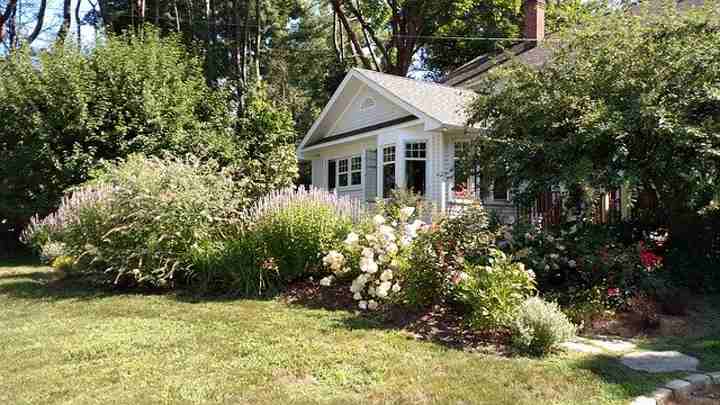
Foundation plants raise the visual entreatment of the house and hibernate its foundations
Growing foundation plants has many visible and practical benefits. The right types of low-growing shrubs hibernate the property's foundations, creating a natural transition from garden to the business firm. Choosing the right foundation plants makes your property more than attractive and highly-seasoned and can even increase its value.
How to Choose Foundation Plants for the Front Yard

Low growing evergreen shrubs are great choice as landscaping plants for the front end yard
Some first-class depression maintenance shrubs such every bit boxwood, wintercreeper, rhododendrons, and holly are all suitable foundation plants. These short, evergreen bushy plants keep their foliage all year. The plants abound in sun or partial shade. They are drought-tolerant and don't grow besides tall.
Low-growing shrubs that are attractive all twelvemonth are first-class choices for foundation plantings. These shrubs are ideal considering they won't cake views from your window. Also, consider the amount of sun your front end yard gets when choosing plants—some foundation plantings need full lord's day, whereas others abound better in the shade.
Drought-tolerant plants are as well platonic for foundation planting. Letting the soil dry out between watering helps to prevent dampness around your dwelling house. That is why it'due south a good idea to plant curt shrubs 3 ft. (one m) apart. Enough of air circulation around plants most your foundation likewise helps proceed clammy away from your holding.
Avoid shrubs or pocket-size trees that have invasive roots because they tin can bear on the property's foundation. These larger shrubs should be planted at to the lowest degree 5 ft. (one.5 chiliad) from your domicile.
Types of Foundation Plants – Excellent Landscaping Shrubs for Front of Firm
What are the best low-growing landscaping plants to abound along the front of your firm? Let's look in detail at platonic foundation plants to beautify your garden and enhance your home's adjourn entreatment.
Boxwood (Buxus) Shrubs for Foundation Plantings

Buxus microphylla 'Green Pillow' (in the picture) is a compact depression growing evergreen shrub with rounded shape
Depression-growing, compact boxwood shrubs are perfect for foundation planting in your front yard. Boxwood are low maintenance foundation plants that have dumbo, lush evergreen foliage and bushy growth. The hardy low maintenance shrubs are easy to trim, and about cultivars don't grow college than 3 or iv ft. (1 – ane.2 m).
Many boxwood varieties grow in full sun, partial shade, or full shade. Piece of cake to abound boxwoods thrive in well-draining soil and are by and large tolerant of drought. The hedge plants thrive in zones v – 9.
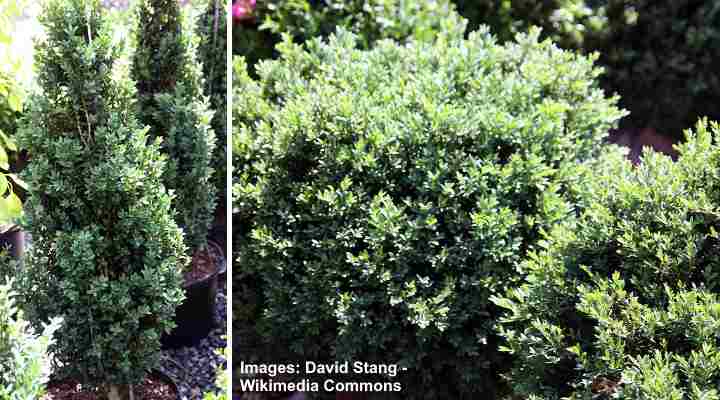
Boxwood 'Dee Runk' (left) and 'Dark-green Gem' (right) are slap-up low maintenance landscaping shrubs for the front of the house
Hither are some of the best boxwood shrubs for foundation planting:
- Boxwood 'Winter Gem' (Buxus microphylla 'Winter Jewel')—This foundation plant has a rounded shape and grows upwards to four ft. (i.2 m). 'Winter Precious stone' boxwood has small glossy light-green leaves that retain their color all year. Suitable for zones 6 – 8.
- Japanese Boxwood 'Green Dazzler' (Buxus microphylla var. japonica)—The 'Green Beauty' boxwood has lush foliage and glossy lanceolate leaves. This low maintenance modest foundation shrub grows well in shade and lord's day. Suitable for growing in zones 6 – ix.
- Common Boxwood (Buxus sempervirens 'Suffruticosa')—The common boxwood is one of the best foundation planting choices. The dwarf boxwood grows to between ii and iii ft. (0.6 – 1 k) alpine, has evergreen leaves and is drought-tolerant. Grow common boxwood for formal low hedges, footing cover for shade or sun, or every bit a container entrance institute.
- Boxwood 'Green Pillow'—The 'Green Pillow' boxwood is a low-growing broadleaf shrub that is ideal as a foundation plant. The dense shrub looks similar a pincushion pillow. As a foundation plant, this boxwood grows up to 1 ft. (30 cm) and thrives in zones 5 – eight.
- English Boxwood 'Dee Runk' (Buxus sempervirens)—This tall boxwood shrub is suitable for entrance planting or corner planting. The evergreen shrub has an upright columnar growth and grows around seven ft. (2 m) tall. 'Dee Runk' boxwoods provide yr-round color. You lot tin trim this fast-growing plant to create a foundation planting hedge. Suitable for zones 6 – eight.
- Buxus 'Green Gem'—This little landscaping shrub grows every bit a round mound of night dark-green foliage with small oval leaves. The dense growth habit creates fantabulous low hedges.
Small Yew Shrubs
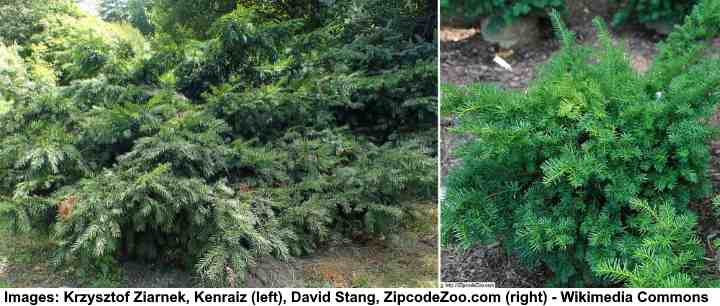
Dwarf yew cultivars are hardy and dense evergreen shrubs and are great equally accent shrubs. In the movie: English yew 'Repandens' (left) and Taxus media 'Densiformis' (right)
The soft needles and dumbo growth of dwarf yew shrubs make these conifers meridian choice when it comes to front 1000 evergreen landscaping bushes. Nigh compact yews accept upright growth and thrive in full sun. Yew dwarf shrubs are excellent hedging plants, ornamental border shrubs, or attractive foundation plants.
Here are a few types of suitable yews for foundation planting:
- Anglo-Japanese Yew (Taxus x media 'Densiformis') – Anglo-Japanese yews are ideal semi-dwarf foundation plants. This yew diverseness is a depression-growing shrub with dense foliage made upwards of glossy green needle-like leaves. The shrubby yew grows to 3 or 4 ft. (one – ane.2 m) tall. The 'Densiformis' yew is an excellent choice for planting in shady areas around foundations. Low-maintenance, drought-tolerant, and evergreen leaves mean that Anglo-Japanese yew has the perfect characteristics of a foundation plant. Platonic for growing along the forepart of your house, Anglo-Japanese yews thrive in full sun, partial shade, and total shade in zones iv – seven.
- English language Yew (Taxus baccata 'Repandens')—A low-growing ornamental foundation constitute with spreading growth. English yews grow to between 2 and iv ft. (0.half dozen – 1.2 thousand) and up to 15 ft. (4.5 yard) wide.
- Japanese Yew 'Bright Gold' (Taxus cuspidata)—This dwarf foundation shrub has spreading growth and grows around four or 5 ft. (1.2 – 1.five m) tall. The foundation found grows best in full sun or partial shade in zones iv – vii.
Cavatine Dwarf Japanese Pieris (Pieris japonica 'Cavatine')
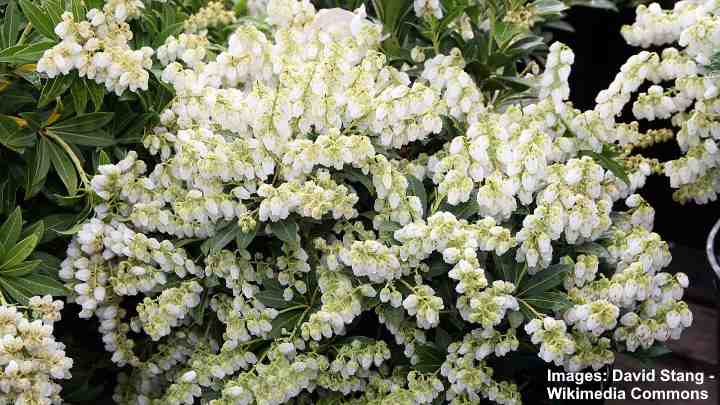
The low growing Pieris japonica 'Cavatine' looks beautiful in any foundation landscaping
The Pieris japonica 'Cavatine' is a flowering dwarf shrub with evergreen foliage. The 'Cavatine' plant is a foundation plant growing up to two ft. (0.6 yard) tall. Flossy-white flowers add color that contrasts with the dark light-green foliage. Likewise called the lily-of-the-valley shrub, this is a low informal hedge constitute.
Dwarf 'Cavatine' shrubs grow in full sun or partial shade in your front garden. The Japanese Pieris foundation plants are drought-tolerant and grow well in zones half-dozen – 8.
Rhododendron – Foundation Plants for Front Yards
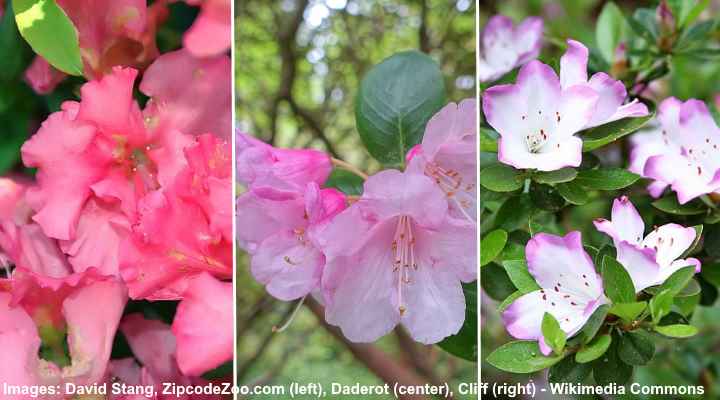
Evergreen cultivars of flowering dwarf Rhododendrons include: 'Hino Crimson' (left), 'Bow Bells' (center) and Dwarf Indica Azalea (right)
Rhododendrons are evergreen flowering shrubs for planting at the front of your house. Many rhododendron shrubs are ideal foundation plants every bit they grow to betwixt ii and iv ft. (0.6 – 1.2 yard) alpine. Evergreen rhododendrons are excellent choices for full sun or partial shade effectually foundations. Rhododendron shrubs produce stunning flowers in spring.
Here are some of the best rhododendron shrubs for forepart yard foundation planting:
- Rhododendron 'April Rose'—This hardy semi-dwarf bush-league has large purple flowers, broad green leaves, and is extremely cold-hardy. This foundation plant grows 3 to 4 ft. (ane – 1.2 1000) tall and thrives in zones 4 – 8.
- Rhododendron 'Dora Amateis'—This spectacular pocket-sized shrub blooms with masses of white flowers every jump. The depression-growing, bushy foundation plant grows in the sun and shade. Ideal for planting in front end yards in zones 5 – 8.
- Rhododendron 'Hino Cerise'—The 'Hino Crimson' rhododendron is a stunning flowering shrub for your business firm'southward front k. Only growing to 2 or iii ft. (0.6 – i thou) alpine, the low bush has shiny evergreen foliage and showy dark pinkish flowers. Grow in zone 5 – 9.
- Rhododendron 'Bow Bells'—Beautiful clusters of pink scented flowers cover this small evergreen shrub when it blooms. Glossy, greenish foliage retains its color throughout the winter.
- Dwarf Indica Azalea (Rhododendron eriocarpum)—Evergreen in well-nigh climates, this dwarf flowering shrub only grows to virtually 2 ft. (0.vi m) tall. Grow this rounded broadleaf bush in shrub borders, as a small flowering hedge, or an accent institute.
Observe the all-time pocket-size flowering shrubs.
Inkberry Foundation Plants (Ilex glabra)
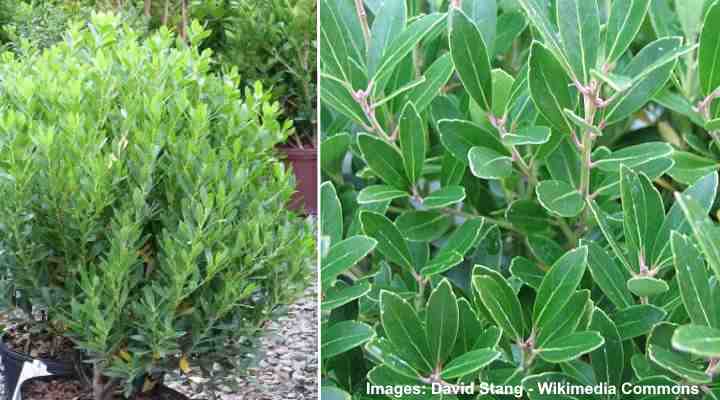
If you are looking for foundation planting ideas, Inkberry 'Shamrock' is a depression maintenance small shrub for front of house
Inkberry shrubs such as the 'Shamrock' (Ilex glabra 'Shamrock') are perfect for foundation planting. Inkberries are evergreen shrubs that produce flowers in summer and blackness berries in the fall. The Inkberry 'Shamrock' cultivar has thick, nighttime green leaves for year-long color in your front k. Inkberry 'Shamrock' plants abound to 3 or four ft. (i – 1.2 m).
Inkberry shrubs abound just as well in total dominicus or partial shade. The bushy foundation plants grow in all types of soil and don't mind wet ground. These shrubby, low-growing, easy-care plants thrive in zones 4 – nine.
Here are some other inkberry foundation plants:
- Inkberry 'Strongbox'—This low-growing meaty shrub has modest leaves, thick foliage, and grows up to 3 ft. (1 thou) tall.
- Inkberry 'Jewel Box'—Looking like boxwood, the 'Jewel Box' inkberry foundation found has small dark green leaves, compact growth, and survives soggy soil and full sun.
Arborvitae Foundation Plants (Thuja)
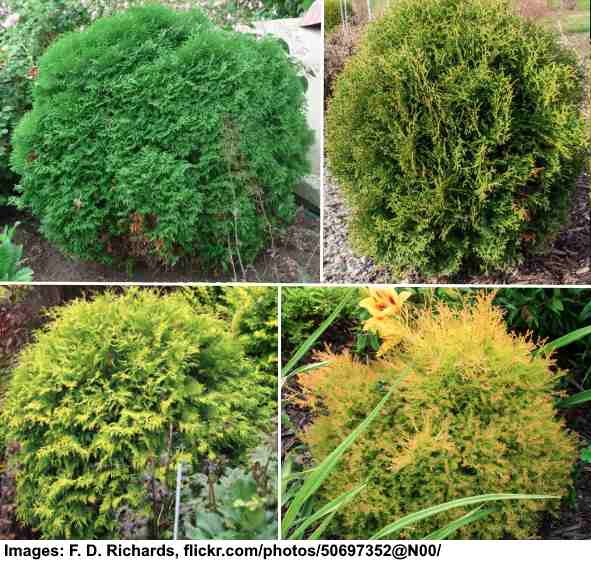
This picture shows dwarf arborvitae (thuja) cultivars, clockwise from top left: 'Little Giant', 'Hetz Midget', 'Fire Chief' ('Congabe') and 'Aurea Nana'
Dwarf arborvitae shrubs are excellent foundation plants with soft, evergreen leafage. Small varieties of arborvitaes abound best in full sun along the forepart of houses. Or yous tin grow taller upright, compact arborvitae trees as corner plantings or archway plantings. Arborvitae shrubs grow in zones 3 – 7.
Hither are some of the all-time arborvitae choices for growing effectually the foundation:
- Dwarf Golden Oriental Thuja (Platycladus orientalis 'Aurea Nana')—This dwarf evergreen shrub has gold-yellow foliage and soft needle leaves. Abound in sunny or partially shaded front yards to hibernate foundations.
- Thuja occidentalis 'Trivial Behemothic'—This conifer species is an splendid choice for foundation plantings. The arborvitae has a compact dome shape with soft green feathery foliage. Grow in sunny front yards around foundations.
- Thuja occidentalis 'Hetz Midget'— The pretty compact rounded shrub has a flattened meridian and soft conifer feathery leaves. Plant this easy care arborvitae along the front of your house as a foundation plant.
- Thuja occidentalis 'Fire Primary'— The brusque shrub has dense feathery foliage that is golden yellow in spring. It gradually turns green and blood-red in the fall. This low-growing arborvitae is perfect for foundation plantings, low hedges, or borders. 'Fire Primary' arborvitae grows to three to 4 ft. (1 – 1.2 g) in zones v – 9.
Wintercreeper (Euonymus fortunei) Shrubs for Foundation Plantings
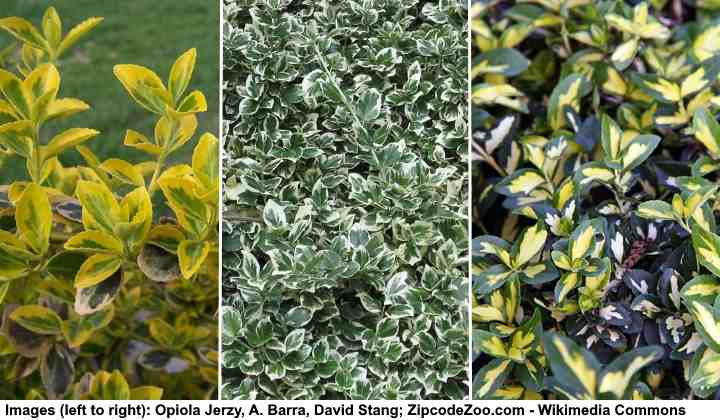
The colorful leaf of minor evergreen Euonymus shrubs adds ornamental element to your front end garden. This picture shows the compact cultivars: 'Emerald 'n' Gold', 'Emerald Gaiety' and 'Moonshadow'
Wintercreeper shrubs are foundation plants with golden yellow and dark-green foliage. Wintercreeper cultivars grow to between one and ii ft. (30 – 60 cm) and are platonic for hiding foundations, footing cover, edging, or garden borders. These cold-hardy, brightly-colored plants grow only as well in the shade as in full sunday.
Wintercreeper shrubs grow in zones v – 9. Earlier planting them about your foundation, bank check with your state equally they are considered invasive in some areas.
Here are some wintercreeper shrubs for foundation planting:
- Euonymus fortunei 'Emerald 'n' Gold'—This wintercreeper will brighten your front yard with its yellow and brilliant light-green foliage. Ideal for planting around foundations in shaded areas of your g.
- Euonymus fortunei 'Moonshadow'—Lush greenish and yellow foliage provides stunning foundation cover in sunny or shaded front yards. 'Moonshadow' wintercreeper grows up to 3 ft. (one chiliad) tall with a 5 ft. (1.5 g) spread.
- Euonymus fortunei 'Emerald Gaiety'—White and green variegated foliage on this low-growing bushy evergreen shrub creates an first-class footing cover. Grow in sunny front yards as a foundation plant, low hedge, or to climb upwards walls.
Dwarf Spruce Shrubs for Forepart of House Planting
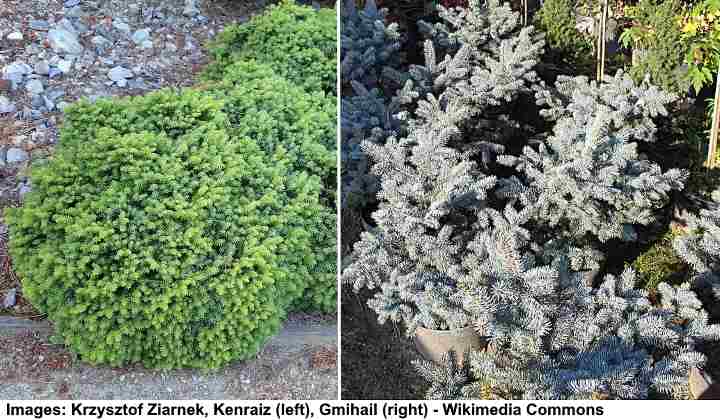
In this image: Picea abies 'Little Gem' (left) and Picea pungens 'Glauca Globosa' (correct)
Dwarf bandbox shrubs add plenty of curb entreatment to your front grand. Bandbox conifer shrubs are low-growing, evergreen plants that abound best in full sun. Their blue-green colors, needle-like leaf, and spreading growth make them a perfect choice for foundation plants. Bandbox shrubs and copse abound in zones iii – eight.

The birds nest spruce (Picea abies 'Nidiformis') is a irksome grower shrub with round shape and flat superlative
Here are some of the all-time bandbox conifers for foundation planting:
- Bird's Nest Norway Spruce (Picea abies 'Nidiformis')—This foundation constitute has an oval shape with a flattened top. The 'Bird's Nest' spruce has dense light green foliage. The low-growing conifer grows to 3 or four ft. (1 – 1.2 m) alpine.
- Dwarf Kingdom of norway Spruce (Picea abies 'Tompa')—The 'Tompa' spruce cultivar has a conical shape that doesn't grow higher than 3 ft. (1 thousand). Plant equally a foundation plant or archway institute in a sunny forepart 1000.
- Dwarf Black Spruce (Picea marina 'Nana')—The dwarf bandbox shrub is a cute round foundation plant that only grows two ft. (threescore cm) alpine.
- Dwarf Alberta Spruce (Picea glauca 'Conica')—This foundation conifer plant has a pyramid shape. Its light green leaf and ornamental look make it ideal for landscaping at corners, every bit entrance plantings, or to add a visual emphasis to other foundation plants.
- Picea abies 'Little Gem' – A dwarf evergreen spruce shrub with needle-like dense foliage and flattened round shape. This compact shrub volition look bully in a rock garden or in front of other taller shrubs.
- Picea pungens 'Glauca Globosa'—Pictures of this miniature bandbox testify a globe-shaped, bluish-needled shrub. The slow-growing dwarf evergreen will somewhen reach about 3 or iv ft. (1 – 1.two one thousand) alpine.
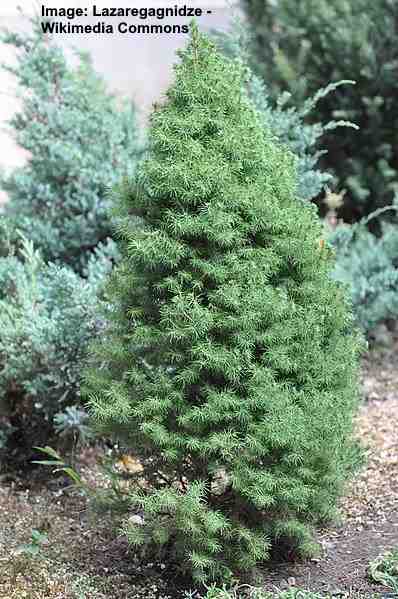
Picea glauca 'Conica' (dwarf Alberta bandbox)
Hydrangea – Flowering Foundation Shrubs

Bigleaf Hydrangea or Mophead Hydrangea (Hydrangea macrophylla)
Hydrangeas are deciduous ornamental foundation shrubs with a rounded shape and clusters of large globular flowers. Hydrangeas are popular flowering landscaping plants for front of house due to their low-maintenance requirements and their showy flower clusters during summer.
Most hydrangeas are big flowering shrubs that grow between 3 and five ft. (1 – one.v thou) high. Several species of hydrangea accept a compact, brusk growth that makes them ideal flowers for small-scale gardens and the forepart m.
Hydrangea are like shooting fish in a barrel intendance landscaping shrubs that have average water needs, and are not fussy nigh the soil. Hydrangea shrubs grow best in partial shade, however, some hydrangea flowers flourish in full lord's day. The but intendance these shrubs demand is pruning spent flowers.
The beautiful hydrangea flowers flower for many weeks in the summer and abound as clusters of flowers in shades of blue, lavender, white, pink, red, green, and purple.
Found an easy-care small variety of hydrangea shrubs in front of the house, as an accent flowering plant, or grow in a row to create a colorful hedge. Every bit a bonus, the beautiful large flowers look stunning in cut blossom floral displays.
Nigh hydrangea cultivars thrive in USDA zones 3 – 9.
Here are some of the all-time hydrangea shrubs for front grand foundation planting:
- Hydrangea macrophylla 'Nikko Blue' – This is ane of the most pop mophead hydrangea shrubs for foundation planting. Flowers are blue in acidic soils and develop pink hues in alkaline soils. This ornamental hydrangea institute grows to 4 – vi ft. (1.ii – 1.8 m) alpine and wide.
- Hydrangea macrophylla 'Endless Summertime Bloomstruck' – a hardy mophead hydrangea variety with attractive rounded growth habit and two-toned lilac or pink flowers. Information technology grows to 3 – 4 ft. (1 – i.2 chiliad) tall and up to 5 ft. (1.5 m) wide.
- Hydrangea paniculata 'Fiddling Lime' – This is a compact dwarf shrub for front of house that doesn't grow higher than 5 ft. (ane.5 m). This hydrangea produces lime-green flowers, large pointed green leaves, and has round, mounding growth.
- Hydrangea arborescens 'Annabelle' – This front of house plant has spectacular huge showy white flowers. 'Annabelle' hydrangea has a compact, rounded growth addiction, making it platonic for foundation planting. This like shooting fish in a barrel care landscaping shrub grows to three – 5 ft. (one – 1.5 m) tall and 4 – half-dozen ft. (1.2 – ane.8 m) wide.
- Mount Hydrangea (Hydrangea serrata) – This is one of the smaller varieties of hydrangea with showy calorie-free pink or light bluish flowers and lush green leafage. Ideal for growing in front of the house, or as a colorful shrub border. Information technology grows to 2 – 4 ft. (0.6 – 1.2 g) tall and wide.
Foundation Trees for Corner Firm Plantings
Upright conical evergreen copse and shrubs such equally arborvitae, spruces, boxwood, and yews are excellent choices for planting at house corners. Columnar trees tin frame the forepart of your house and accent your other foundation plants. Ideally, corner plants should be small or dwarf trees that are bonny throughout the yr.
When planting trees at the corner of your house, ensure they are not too shut to the building. Every bit trees grow and mature, they spread out. Then, they shouldn't conceal your house's corners, but they should accent its architectural features.
Here are some splendid choices for trees to grow near the corner of your firm.
American Arborvitae 'Smaragd' (Thuja occidentalis 'Smaragd')
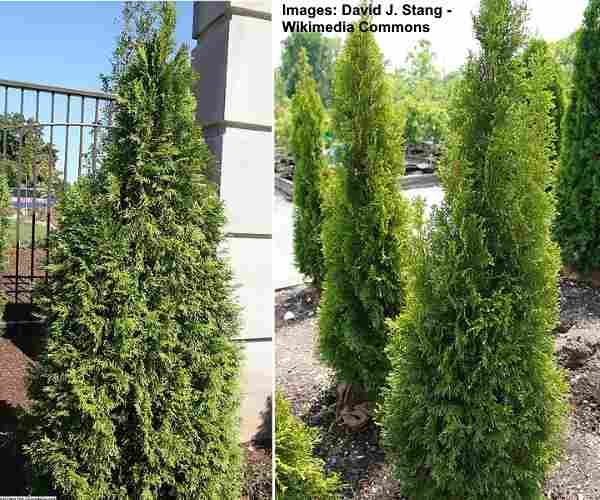
American arborvitae 'Smaragd' is a minor tree that is suitable to accents the entrance or corner of the house
The Smaragd arborvitae is a columnar tree that gives visual appeal to the corners of your house. These narrow arborvitae semi-dwarf trees have lite green, feather leafage. Slow-growing and easy to grow, the 'Smaragd' reaches heights upwards to 14 ft. (4.2 thousand) tall.
Besides called 'Emerald Green' arborvitae, you tin grow Smaragd evergreen conifer trees in containers at your entrance.
Upright Japanese Plum Yew (Cephalotaxus harringtonia 'Fastigiata')
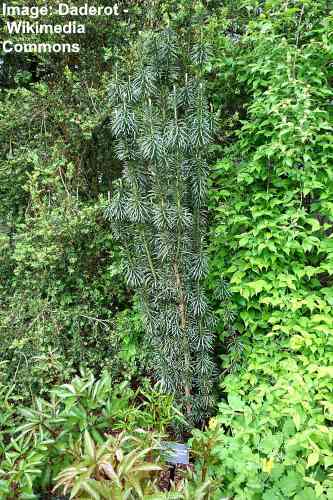
Upright Japanese plum yew is a beautiful minor columnar tree for landscaping the corner of the house
The Upright Japanese Plum Yew is a skinny compact evergreen tree, ideal for planting at the corners of your business firm. This evergreen yew grows to 8 or 10 ft. (2.4 – 3 grand), has erect upward growing stems, and blackish-greenish leaves. Plant in sunny or partially shaded gardens to give visual entreatment to the edges of your house.
Redbud (Cercis) Tree
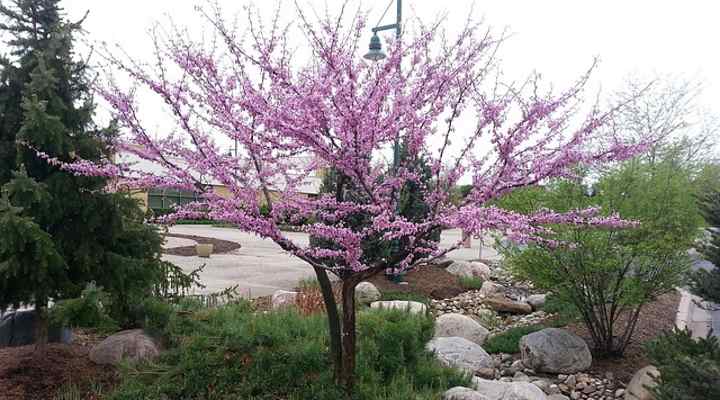
Redbud is a small-scale depression maintenance flowering tree for the forepart of business firm
Redbuds are small-scale ornamental flowering copse with pink flowers that you can institute near the corner of your dwelling house. Redbuds turn a stunning rosy-pink color when they flower in spring. Lush, centre-shaped leaves cover the tree in summer and autumn. Although redbuds are deciduous trees, their intricate stems and co-operative patterns provide a fascinating wintertime silhouette.
Observe the best flowering plants for the front end yard.
Related articles:
- Small Trees for Landscaping Small Spaces
- Pocket-sized or Dwarf Weeping Trees for Landscaping
- eighteen Different Types of Shrubs to Grow in The Yard
Read Next
palmatierdets1943.blogspot.com
Source: https://leafyplace.com/foundation-plants/
0 Response to "Best Low Growing Shrubs for Front of House"
Publicar un comentario